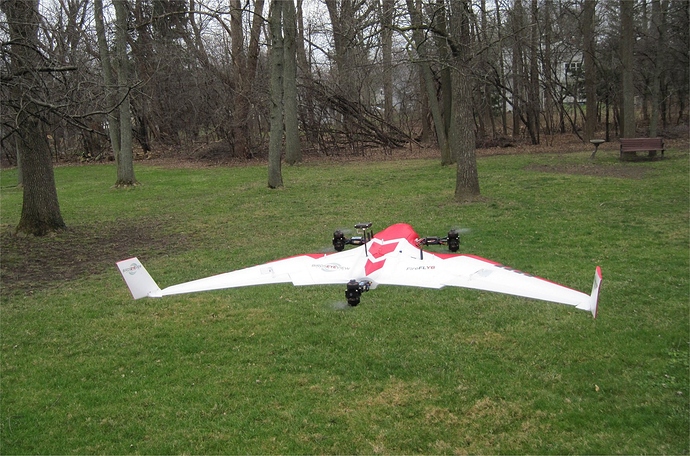Hi,
Leveraging Tridge’s work on tilt-rotor features in Plane v3.8.2 and his testing of the BirdsEyeView Aerobotics FireFLY6 VTOL wing using APM, I decided to convert my DIY15 3s model from AvA to Plane v3.8.2. If I like it then I will convert my DIY25 6s model as well.
I’ll transfer information pertaining to the FF6 from the rather large tilt-rotor thread in the Developers forum so this thread can stay focused on setup and testing of this specific model. I will try to keep all the information needed to convert from AvA to APM in this first post so it will evolve over time.
Here is what the FF6 looks like hovering with the gear up. It can carry a 2.5lb (1134g) payload underneath.
Tridge’s initial .param file (posted below) for the FF6 DIY15 using Plane v3.8.2 was for Pixhawk2, not Pixhawk so I am creating my own and will post it when tested. Some critical parameter differences between the two Pixhawks are AHRS_ORIENTATION and BRD_TYPE.
When loading a QuadPlane enabled .param file for the first time after a firmware upgrade, you will encounter many errors due to the Q_ENABLE transition from 0 to 1. Simply re-load the .param file a second time after first re-booting the Pixhawk.
APMfirefly6.param (23.9 KB)
Tridge’s param file above flew with these gain settings:
- Q_A_RAT_PIT_D 0.003600
- Q_A_RAT_PIT_I 0.250000
- Q_A_RAT_PIT_P 0.250000
- Q_A_RAT_RLL_I 0.300000
- Q_A_RAT_RLL_P 0.300000
- Q_A_RAT_YAW_I 0.018000
- Q_A_RAT_YAW_P 0.180000
Tridge’s latest tuning below resulted in a bit higher gains for the multicopter. I’ll be using these settings in my .param file.
- Q_A_RAT_PIT_D 0.003600
- Q_A_RAT_PIT_I 0.400000
- Q_A_RAT_PIT_P 0.400000
- Q_A_RAT_RLL_I 0.500000
- Q_A_RAT_RLL_P 0.500000
- Q_A_RAT_YAW_I 0.060000
- Q_A_RAT_YAW_P 0.350000
Tridge also added the Y6F (for “FireFly6”) layout to ArduPilot 3.8.x so that there is no change in motor direction or connection to the Pixhawk. Very nice! (Q_FRAME_CLASS = 5, Q_FRAME_TYPE = 11)
The layout is:
- Motor1: rear-CCW
- Motor2: front-rght-CCW
- Motor3: front-left-CCW
- Motor4: rear-CW
- Motor5: front-right-CW
- Motor6: front-left-CW
The main mapping and connections to the Pixhawk mimic the AvA setup:
- Left Elevon = Servo 1 = 77 = MainOutput1
- Rightt Elevon = Servo 2 = 78 = MainOutput2
- Motor 1 = Servo 3 = 33 = MainOutput3
- Motor 2 = Servo 4 = 34 = MainOutput4
- Motor 3 = Servo 5 = 35 = MainOutput5
- Motor 4 = Servo 6 = 36 = MainOutput6
- Motor 5 = Servo 7 = 37 = MainOutput7
- Motor 6 = Servo 8 = 38 = MainOutput8
- Retracts = Servo 10 = 57 = AUX2
- Tilt Servo = Servo 11 = 41 = AUX3 (Note that this is normally AUX1 on AvA setups)
Here is my initial .param file for the Pixhawk 1 that hovered nicely in my backyard using a FrSky Taranis. I will post my Taranis .eepe model file soon.
GregsFF6wAPM_Hover1.param (16.0 KB)
Slight changes after re-calibrating the radio and re-testing a good hover.
GregsFF6wAPM_Hover2.param (16.0 KB)
Corrected tail-heavy CG and also changed:
PTCH2SRV_P from 1.1 to 1.8
EK2_IMU_MASK from 1 to 3
GregsFF6wAPM_Hover3.param (16.0 KB)
Q_RTL_MODE = 1
THR_FS_VALUE = 950
GregsFF6wAPM_Hover4.param (16.0 KB)
Taranis X9D+ with 6-position Flight Mode Switch (ZIPed .eepe file)
FireFLY6withAPM.zip (6.9 KB)
My second flight of the FireFLY6 using APM Plane v3.8.2 was as good as the maiden flight. Transitions seemed flawless and I had better turning capability than when using AvA because it can be set to the user’s needs.
I took off and landed in our tiny mowed opening surrounded by hazards. Once airborne, I had a large wild field to fly over. Landing can be tricky when the wind is blowing because the take-off and approach are from the same direction. Other than a little prop turbulence during my descent, the flight was great!
Interesting Links:

